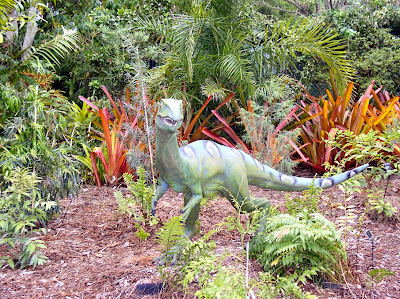The normally serene and peaceful Naples Botanical Garden has been taken over by life-sized animatronic (animated by electronics) dinosaurs that move, snarl, roar, open their jaws, blink their eyes, move their arms and one that even spits water at people. The dino designers have done their research, too, getting tips on movement, sound, skin texture and more from world-renowned dino experts. The ten dinosaurs have steel skeletons and a realistic, urethane-compound skin. Each dinosaur has its own power source and a computer “brain” that controls its movements. Some are located in the Brazilian Garden, but the Florida Garden, with its open, grassy space seems a more natural location for the dinos. The exhibition’s dinosaurs span the Mesozoic era, with species from the Triassic, Jurassic and Cretaceous periods. In addition to the dinos, the garden strategically placed and planted era-appropriate plants like cycads and ferns with Triassic species, and flowering plants with Cretaceous period species.
This entrance to the Event Plaza faces the parking lot.
Welcome to “Gardens with Latitude,” latitude meaning the same geographical band and also freedom of choice to enjoy the garden in different ways.
Dinosaurs Exhibit Sign
The exhibit dates are March 14 through July 5, and it is open from 9:00AM to 5:00 PM.
A tropical water lily in the pool
A Garden Guide shows us a leaf on which a butterfly has laid eggs.
Carmen in the Children’s Garden in front of a child-sized cottage
A mosaic-decorated tub of succulent plants in the Children’s Garden
The first dinosaur that Carol, Carmen, Marlene and Pauline saw was the Brachiosaurus.
The head of the brachiosaurus high among the tree branches
It was plant-eating and well-suited to be a “high browser”
A Dilophosaurus mother, a Jurassic period predator, is notable for having a pair of rounded crests on its skull.
Martha in front of the Dilophosaurus
This is the baby Dilophosaurus. Even though there was no evidence that these animals spit poison, this one sprays water on unsuspecting passersby.
Martha in front of the Dilophosaurus
This is the baby Dilophosaurus. Even though there was no evidence that these animals spit poison, this one sprays water on unsuspecting passersby.
Dilophosaurus Information Sign
The Triassic period star, the Coelophysis, is a primitive bipedal carnivorous dinosaur that may have hunted in packs. The plants that lived in this timeframe were cycads, ferns, and non-flowering plants.
One Coelophysis, a small (by dinosaur standards), slenderly-built, fast and agile runner
The other Coelophysis in the exhibit
Coelophysis Information Sign
The LaGrippe Orchid Garden will rotate hundreds of species of orchids and feature some of the world’s smallest and largest varieties. Oftentimes, orchid exhibits at botanical gardens are in a hothouse environment. These orchids are displayed in an open-air, more naturalistic way.
The floor is paved with Florida coral rock. Huge oolitic (made up of small, egg-shaped particles) limestone boulders are planted with orchids and other epiphytes.
Medinilla, sometimes called “Malaysian Orchid”

Cattleya Orchids
Another rectangular limestone fountain continues the theme from Kathryn’s and Irma’s Gardens and also provides the cooling sound of moving water.
In the Brazilian Garden, a bloom on a water chestnut tree, commonly called the “Money Tree,” supposedly because it will bring prosperity to your home.
In planning the Naples Botanical Garden, it was decided that the Garden should reflect the plants of areas that are the same latitude as Naples. Brazil is one of these areas, so building the Brazilian Garden was a logical decision. In addition, Brazil is the homeland of Roberto Burle Marx, widely considered to be the father of modern landscape architecture.
The plaza is atop an infinity pool from which waterfalls cascade into a lake.
The centerpiece of the Brazilian Plaza is an original Burle Marx ceramic mural, a massive 7-by-18-foot piece. The Garden Guide is speaking with our group about the Brazilian Garden.
A tropical water lily in the infinity pool of the Brazilian Plaza. The water looks black because it is dyed black, with a natural vegetable dye.
A Wisteria promenade leads visitors to the Florida Garden, where the rest of the dinosaurs are located.
The Edmontonia dinosaur was bulky, broad and tank-like.
T-Rex Information Sign
It is speculated that the fearsome appearance of the Styracosaurus was needed to fend off enemies, or that bigger frills and sharper spikes may have attracted more females of the species.
Styracosaurus Information Sign
The regulation of body heat is one of the more functional explanations of the crest.
Parasaurolophus Information Sign
Parasaurolophus Information Sign
Stegosaurus Information Sign
Stage 62 Deli in the Mercato in Naples






















































No comments:
Post a Comment